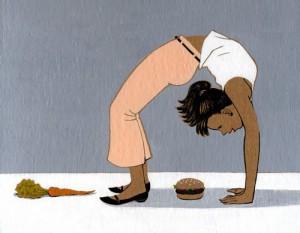Yes, you read that correctly. Meat-eating vegetarians do exist, and in fact, they are rapidly growing in numbers as studies continue to yield results that look upon the meat-centric American diet unfavorably. Semi-vegetarians, commonly known as flexitarians, eat a mostly vegetarian diet but are willing to occasionally eat meat, poultry, or fish. Most have made the diet switch for health reasons, and while they mostly eat a plant-based diet, they allow for a meaty treat every now and again – some more than others.
In recent years, the market for vegetarian foods has exploded, and experts say that most of the growth is not from the truly committed vegetarians who only make up 3% of the U.S. population. Interestingly enough, we actually have flexitarians to thank for the veggie food boom. While critics have been known to compare being “almost vegetarian” to being almost pregnant, the trend is steadily growing with no signs of turning back.
 According to the registered dietitian who wrote The Flexitarian Diet, “Vegetarianism is one of the healthiest and smartest ways to eat, and it is perfectly acceptable to pepper in meat and still be able to gain all of the health benefits.” And she’s not the only one sending that message. There’s a lot of scientific evidence to support the healthfulness of a diet made up mostly of plant foods. And the cherry on top? Eating less meat is better for the environment…and your wallet.
According to the registered dietitian who wrote The Flexitarian Diet, “Vegetarianism is one of the healthiest and smartest ways to eat, and it is perfectly acceptable to pepper in meat and still be able to gain all of the health benefits.” And she’s not the only one sending that message. There’s a lot of scientific evidence to support the healthfulness of a diet made up mostly of plant foods. And the cherry on top? Eating less meat is better for the environment…and your wallet.
So, if you’re convinced that you’d like to give flexitarianism (Did we make that up???) a try, here are some great tips from Woman’s Day magazine to get you started:
- Set a goal of how many days you’d like to go meatless each week. Many people start with as little as two and eventually do four or more.
- Add, don’t subtract. Try eating new sources of protein like beans and tofu instead of just taking away meat. Adding beans to chili or tofu to stir-fry dishes will help your taste buds adjust.
- Try the 50/50 swap. Trade half of the meat portion of your meal for vegetable protein like beans, tofu, or a high-protein grain like wild rice, high-protein pasta, or quinoa. For example, try a half-steak, half-black-bean taco. Gradually work your way up to making the meal 100% meatless.
- Get the right grains. They’re an important, satisfying part of a plant-based diet. Go with whole grains, which have more protein, fiber, and nutrients than refined ones like white rice. Substituting brown rice for white rice and whole-wheat pasta for regular is a good first step. The next step is venturing into more exotic grains like bulgur, quinoa, millet, and barley.
- Don’t forget the dairy. It’s an important source of calcium and vitamin D, and you need about 2 cups of reduced-fat milk, yogurt, or cheese a day. If you don’t do dairy, you can get the equivalent with fortified soy or almond milk.
- Satisfy a meat craving. Many people who crave meat aren’t wanting the actual protein as much as the meaty flavor known as umami. Many foods – including mushrooms, cooked tomatoes, aged parmesan, and soy sauce – have that supersavory flavor.


